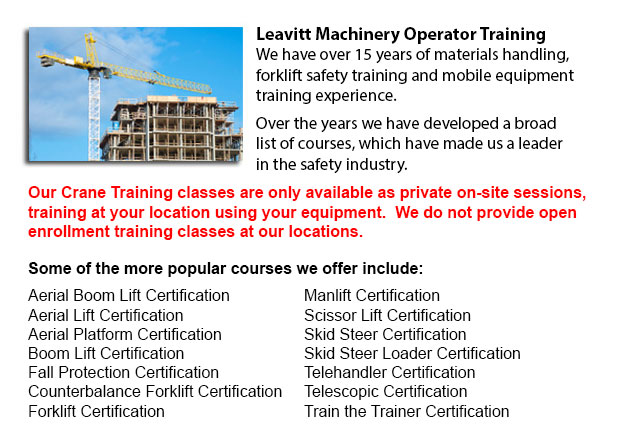
Sudbury Overhead Crane Safety Training - The overhead crane safety training course is meant to equip the operators with the right skills and knowledge in the areas of: crane safety precautions, materials handling, accident avoidance, and stock and equipment protection. Each of the trainees will get to learn on numerous kinds of overhead cranes, their capabilities and their uses in various environments. For operators who are trained and licensed, the shift in liability moves to the operator from the company. Hence, the program emphasizes individual operator tasks.
Overhead crane safety training instructs operators in the proper techniques for carrying out inspections. Two types of pre-shift check are the in-depth inspection and the walk-around inspection. These are vital every day routines which must be logged. Properly recorded pre-shift inspections help to protect the company from liability in case of an accident. Pre-shift checks likewise prevent damage, costly repairs and accidents. Operators learn how to designate a specific individual to handle checks, how to maintain the log book and how to report problems.
Inspections must be performed on a regular basis and documented correctly. The following must inspected while watching for common problems: increase in the throat opening, hooks for cracks, hoist ropes for corrosion, degree of twist, worn wires, loss of diameter, kinks and bird caging, broken wires, heat and chemical damage; chains for nicks and gouges, cracks and corrosion, twists, excessive wear, distortion, pits, stretching, damage from extreme heat.
Operators learn proper rigging measures in this course. Rigging includes understanding the manufacturer's data plate, determining the material weight to be lifted, selecting the gear, and utilizing safe practices to secure the load. The course include in detail the following: safe working loads, and the capacities of chains, ropes, slings, hooks and shackles.
It is vital to understand who may utilize the cranes at your facility, physical requirements of the job, and operator credentials required for specialized job and permits. Safety should be prioritized when operating near pedestrian traffic.
Safe crane operation involves responsibilities like for instance checking for hydraulic leaks, undertaking visual inspections, checking the safety guards, testing the controls, examining the hook and hoist rope, braking mechanisms and limit switches. Proper reporting methods are critical. These topics are all included in depth in the program.
Proper moving and lifting methods with hoists and cranes are covered in the program. Operators would become competent in hand signals. Training involves how to attach the load, raise the load, unhook the slings, abort a lift and set the load.
Moving the load involves some steps: starting and stopping procedures, guiding and controlling the load, working with signals and observing working conditions. Operators should know how to proceed in the event of a power failure. The program includes techniques for lowering the load and removing the slings, storage of equipment, parking the crane, and securing an indoor and outdoor crane.
-
Wheel and Track Loader Training in Sudbury
Lift trucks are obtainable in several different models that have different load capacities. The majority of average forklifts used in warehouse environment have load capacities of 1-5 tons. Bigger scale units are utilized for heavier loads, like for... More -
Sudbury Aerial Lift Certification
Sudbury Aerial Lift Certification - Aerial Lift Certification is for individuals who requires an in-depth understanding of aerial lift safety. Inspectors and operators, supervisors, maintenance workers and construction craftsmen must perform a traini... More -
Sudbury Forklift Certification Schools
Sudbury Forklift Certification Schools - Within North America, forklift certification is mandatory, making forklift training programs necessary for both the company and their employees working as forklift operators. Forklift training focuses on healt... More -
Sudbury Boom Lift Operator Training
Sudbury Boom Lift Operator Training - A cherry picker refers to a type of aerial work platform. Cherry pickers include a platform or bucket at the end of a hydraulic lifting system. The device is likewise called a man lift, boom lift, basket crane or... More -
Sudbury Telehandler Certification
Sudbury Telehandler Certification - Telehandler certification programs are both for operators who have some experience driving a standard forklift and for those with no experience. The real-world training offered by these courses produces graduates w... More -
Operator Safety Training, Re-Qualification Training, In-House Instructor Training in Sudbury
Lift trucks are utilized in just about all industrial construction sites and in warehouse operations and in boat yards. The reach feature of a lift truck is a vital component used in several applications like for example when a shelving system is bei... More -
Crane / Overhead Crane / Self-Erect Crane / Truck Mounted Crane / Hydraulic Cranes Training in Sudbury
Bridge cranes or overhead cranes are a type of industrial material handling crane making use of a line and hook apparatus which runs on a horizontal beam running along two widely separated rails. Lots of overhead cranes could be seen in a long factor... More -
Sudbury Forklift Safety Training
Sudbury Forklift Safety Training - Anyone who wants to operate a lift truck should take a forklift safety training course in order to become a certified forklift truck operator. There are a variety of ways to obtain forklift training. Programs are pr... More

Forklift Certification Sudbury
TOLL FREE: 1-888-254-6157
Sudbury, Ontario
forkliftcertificationsudbury.com
Email Us
About Us


